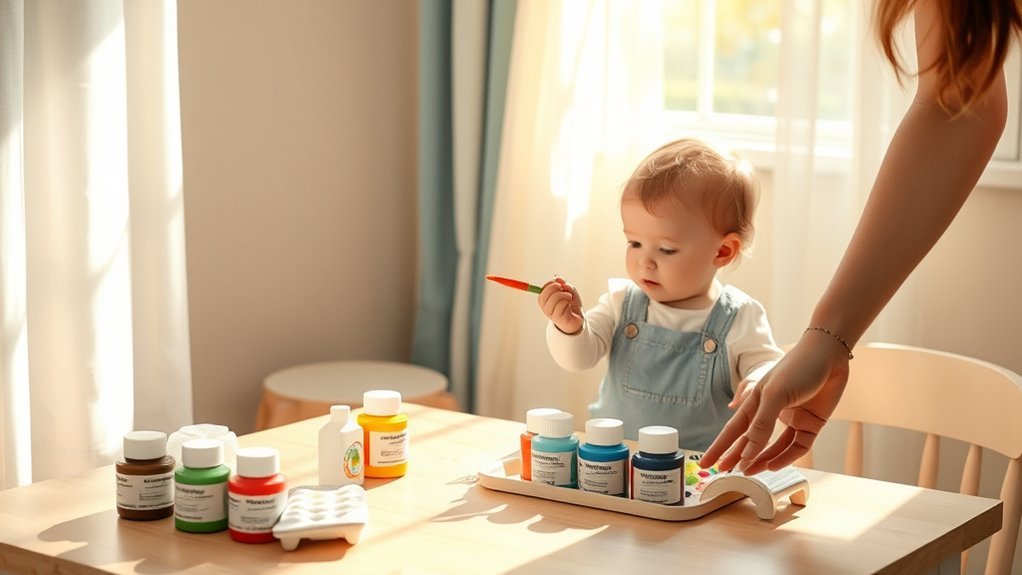When it comes to creating a safe nursery, think of paint as the silent guardian of your child’s environment. Many parents worry about the dangers lurking in paint cans, but not all paint is created equal. Understanding VOCs, lead paint, and non-toxic options is essential for your child’s safety. As you navigate these concerns, you may find some surprising truths that challenge common beliefs about paint and its impact on your little one’s health.
Understanding VOCs and Their Impact on Health
When you choose paint for your nursery, it’s essential to understand the role of volatile organic compounds (VOCs) and their potential impact on your family’s health.
VOCs exposure can lead to various health issues, particularly for sensitive populations like infants. These compounds easily evaporate at room temperature, releasing harmful fumes that can linger for extended periods.
It’s vital to pay attention to VOCs regulations, as they set limits on the amount of these chemicals allowed in paint products. Opting for low-VOC or zero-VOC paints can greatly reduce health risks.
The Truth About Lead Paint in Modern Nurseries
Although many modern paints are free from harmful ingredients, it’s vital to remain vigilant about the presence of lead paint, especially in nurseries.
Lead paint regulations have tightened notably, but older homes may still harbor historical paint hazards. If your nursery is in an older building, it’s important to check for lead paint before painting or renovating.
Even small amounts of lead dust can pose serious health risks to children. The best way to guarantee your child’s safety is to have the paint tested by a professional.
If lead is detected, consider hiring certified experts for safe removal. Protecting your little one’s environment empowers you to create a safe, nurturing space free from the dangers of lead.
Non-Toxic Paint Options: What You Need to Know
Choosing non-toxic paint options for your nursery is essential to confirm a safe environment for your child. You’ll want to explore eco-friendly alternatives that minimize harmful chemicals and VOCs.
Look for paints specifically labeled as non-toxic, water-based, and low-odor. Pay attention to paint certifications like Green Seal or GREENGUARD, which confirm products meet strict safety standards. These certifications provide peace of mind that you’re making a sound choice for your baby’s room.
Don’t overlook colorants and finishes; they can also contain harmful substances. Remember, what you paint with can impact your child’s health, so always prioritize safety and sustainability.
The Role of Paint Curing in Safety
Even with non-toxic paint options, understanding the role of paint curing in safety is crucial. The curing process involves chemical reactions that occur after paint drying, creating a durable, safer finish. Until fully cured, the paint can emit volatile organic compounds (VOCs) that may not be safe for your nursery.
| Stage | Description | Safety Consideration |
|---|---|---|
| Paint Drying | Surface becomes dry to touch | Not fully safe yet |
| Initial Cure | Chemical reactions begin | VOCs may still be released |
| Full Cure | Chemical reactions complete | Safe for children and pets |
Always verify that paint is completely cured before introducing your child to the space. This simple step can help you create a healthier environment.
Debunking Myths About Paint Odors and Child Sensitivity
How much do you really know about the connection between paint odors and your child’s sensitivity? Many believe that all paint odors are harmful, but that’s not entirely true.
Low-VOC and zero-VOC paints greatly reduce harmful emissions, minimizing risks for your little ones. It’s a myth that any smell equals danger; sensitivity varies by individual.
While some children may react to specific odors, most modern paints are designed with safety in mind. Always ventilate the space during and after painting to further decrease exposure.
Remember, your child’s health matters. Choose wisely and opt for safer paint options to create a vibrant, healthy nursery without compromising safety.
Educate yourself and embrace the freedom of informed choices!
Frequently Asked Questions
Can I Paint the Nursery While My Baby Is Sleeping?
You shouldn’t paint the nursery while your baby’s sleeping. Guarantee proper ventilation and choose low-VOC paint types to minimize exposure. It’s best to wait until your little one’s awake or safely away from the fumes.
How Long Should I Wait Before Letting My Child in a Freshly Painted Room?
Wait at least 24 hours before letting your child enter a freshly painted room. Adequate ventilation is essential, especially with oil-based paints, which can release harmful fumes. Water-based paints are safer, but still guarantee proper airflow.
Are All Paint Brands Equally Safe for Nurseries?
Not all paint brands are equally safe for nurseries. Look for eco-friendly options with certifications to guarantee low VOC levels. Prioritize your child’s health by choosing paints that meet safety standards for indoor use.
Should I Avoid Painting During Certain Seasons or Weather Conditions?
You should avoid painting during extreme temperatures or high humidity. Seasonal painting affects drying times and adhesion, risking poor results. Always check weather effects to guarantee a safe, effective environment for your nursery project.
Can I Use Leftover Paint From Another Project in the Nursery?
Using leftover paint might seem like a thrifty idea, but it’s not always safe. Check for harmful chemicals and confirm the paint’s non-toxic before using it in your nursery. Safety first, always!
Conclusion
In the quest for a safe nursery, remember that knowledge is your best ally. By choosing low-VOC or zero-VOC paints and avoiding lead-laden options, you can create a haven for your little one. Don’t let myths cloud your judgment—be proactive and guarantee proper ventilation as paints cure. With every brushstroke, you’re not just decorating; you’re crafting a nurturing environment. So, wield your paintbrush wisely, and transform your nursery into a sanctuary free from harmful toxins.
